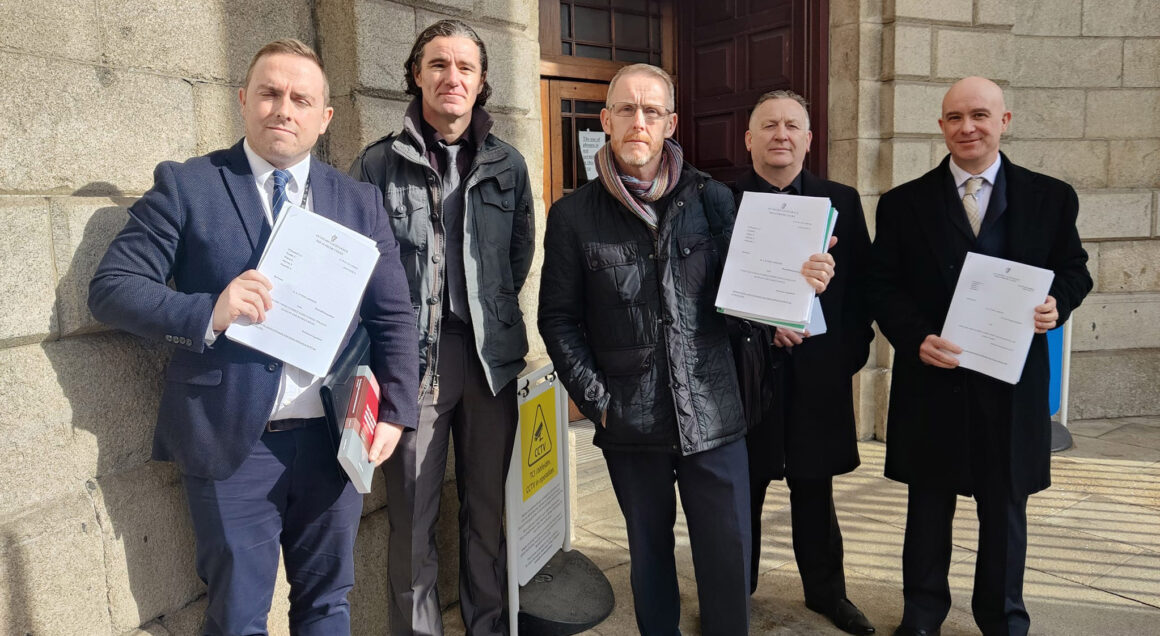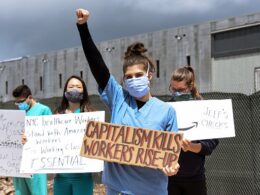By Matt Waine
In a decision that has major ramifications for the whole trade union movement and the right to strike, the Supreme Court ruled on 6 March that the injunction granted to mechanical contracting giant Jones Engineering last year was a bad order and should be disbarred. It further ruled that the defendants, Unite the Union and three of its leading shop stewards, had acted legally and were entitled to the protection of the 1990 Industrial Relations Act.
The injunction was granted in the aftermath of historic strike action by mechanical workers organised by Unite the Union pursuant to the restoration of the first hour of travel time, which had been snatched by the employers in midst of the 2008 economic crash. In the period since then, Unite has been forced to jump through hoops navigating the state’s restrictive industrial relations architecture before legally balloting its members for industrial action. Eventually the path was cleared for significant strike action which took place on 10 March 2023, shutting the prestigious Intel and Pfizer projects in Dublin and Kildare. Fearing an escalation of the dispute, the employers sought and were granted injunctive relief.
It was a strange moment for the trade unionists gathered in front of five Supreme Court judges. Normally when workers and their unions find themselves in such a setting the scales of justice tip in favour of the bosses. There were no representatives from other trade unions despite the landmark nature of the judgement. Even the employers declined to attend. In a session that lasted little more than 15 minutes, the five judges exonerated Unite. This was an enormous win, particularly for the three reps who were attached to the injunction and singled out for trade union activity.
But the significance of the outcome goes far beyond the specifics of this case and sets a precedent that significantly strengthens the democratic right of association and the right to withdraw labour in a bona fide trade dispute.
‘A tool for industrial peace’
The anti-union laws in this country stem from the defeats and setbacks of the 1980s. In the aftermath of the defeat of the courageous year-long Miners Strike of 1984-1985 in Britain, trade union leaders in Ireland drew the erroneous conclusion that a strategy of mobilising the power of the organised working class would inevitably be defeated.
The 1970s and 80s in Ireland was a period of massive industrial unrest. Ireland appeared at the top of the league table for industrial disputes across Europe. During the 1980s an average of 317,000 days were lost to industrial action. In the 1970s, it was nearly 600,000. These disputes were explosions from below, organised by a confident shop steward layer, presenting the union leaders with fait accompli of struggle.
The idea of ‘social partnership’ offered an opportunity for the trade union bureaucracy to begin to claw back control from the rank and file. The social partnership approach was based on wage restraint and bargaining without industrial action. This was combined by a general acceptance of the neo-liberal capitalist status quo, against the backdrop of major ideological attacks on socialist ideas internationally.
In place of strike action, disputes between employers and workers were to be regulated by ‘neutral’ bodies like the Labour Relations Commission (now the Workplace Relations Commission) and the Labour Court. No longer foes, bosses and union leaders were partners, and a whole superstructure of industrial relations processes, procedures and third-party bodies were implemented. The 1990 Industrial Relations Act was an outgrowth of this new relationship of class compromise and industrial peace, and in order to sell it to workers the state and employers conceded, for the first time, the right to strike where the union had fulfilled its obligations under articles 14 and 19 of the Act. The union leaders waved this compromise like Neville Chamberlain in 1938, ‘peace in our time’.
In reality, what the union movement had agreed to was a deal that tied one of its hands behind its back, with political strikes or secondary picketing – the tactics that Larkin had introduced and were central to its foundation as a mass movement – now banned or greatly restricted. Moreover, it mattered little that workers had a limited right to strike enshrined in national law when the new regime of social partnership advocates dominated the leadership of the trade unions, which had no intention of moving workers towards strike action when necessary.
A ruling that will serve workers’ struggles
While unions were able to win concessions for workers in the context of the Celtic Tiger, the reality was that social partnership kept wages relatively low while profits soared astronomically. But the cost was even greater for trade union organisation. Active trade unionism on the shop floor was replaced with partnership bodies. Union membership declined significantly and the crucial layer of shop stewards and workplace reps fell away. Union subs being deducted at source helped erode workplace activity. The unions became ever distant from their membership.
When the economic crisis hit in 2008, the unions were suspended in animation – stunned by the scale of the economic collapse and hamstrung by their fetish-like commitment to social partnership, with no Plan B to defend workers’ jobs, pay or conditions. Two decades of social partnership culture rendered the trade union bureaucracy impotent in the face of a barrage of austerity measures. Indeed, employers dispensed with social partnership as an unnecessary irritant. However, the superstructure and culture of social partnership remained, alongside the anti-trade union laws and the restrictive disputes procedures, effectively outlawing industrial action until elongated engagement procedures were exhausted.
Whereas the 1990 Act only required workers and unions to ballot their members for action and to serve seven days notice to the employer, the ‘disputes procedures’ contained in many local agreements required unions to attempt to resolve the matters at dispute through local engagement with employers, then advancing to the WRC and then advancing to the Labour Court – dragging out the dispute for up to nine months in some cases. Such wars of attrition naturally favour the bosses.
However, the Supreme Court ruling for the first time brings clarity to the relationship between the constitutional rights of association and strike action, and the terms under which a disputes resolution procedure can apply. Essentially, the judgement determined that Unite had met its obligations both under the terms of the disputes resolution procedure and the 1990 Act. However, the judgement went further and determined that, even if Unite had not exhausted the disputes procedure contained within the SEO, it would still have had the right to strike had it fulfilled the obligations of the 1990 Act.
The effect of the judgement, therefore, is to render disputes resolution procedures redundant, meaning a union can take strike action as long as it ballots its members and serves seven days notice.
The urgent need to rebuild
The wave of strikes across Britain and the North, as well as the significant industrial battles in Europe and the US have posed the question – why haven’t we seen similar strike waves in the South? The cynic would say that workers in the South are pliant and servile, not interested in taking militant industrial action and shy away from direct confrontation with their employers. Workers get the unions they deserve, to paraphrase the idiom.
For serious activists this answer doesn’t hold water, but the answer is complex. The Supreme Court ruling is a massive win for workers and trade unions and removes significant obstacles from workers taking industrial action, but it is not a silver bullet. The culture of social partnership built up over nearly 40 years and the dead hand of a bureaucracy whose interests – indeed whose very existence – rests on clinging to the vestiges of social partnership, remain as major hurdles.
Trade union membership in the South has fallen to 24%, whereas in the mid-1970s it was closer to 65%. Take out the public sector and the mass of workers are employed in sectors with little or no trade union organisation. For this to be addressed, a new action programme of trade union renewal is needed, in both traditional areas of the economy, but also newer ones – tech, logistics etc.
Workers need to be convinced that joining a union will mean not only protecting their existing conditions and wages, but also advancing them. Relying on past glories and the proud history of Connoly and Larkin will not convince anyone to join in the face of the continued cost of living squeeze and attacks on living standards.
No trade unionists are cavalier when it comes to disputes, and no worker goes on strike without seriously weighing up the pros and cons. But when considering their options, workers need to be assured that if they choose to take action they will be backed to the hilt by their union. But more than that, trade unions today need to be advocates for industrial action. There needs to be a break with the social partnership mindset of only pursuing demands through the channels of the WRC and the Labour Court.
A union movement for all workers
The power of workers derives from the essential role their labour plays in the economy, particularly in the production of surplus value, from which all profit is derived. This power needs to be organised and leveraged in order to deliver wins for workers. As Unite regional secretary and Socialist Party member Susan Fitzgerald said, “the more strike-ready workers are, the more talk-ready employers are.”
Workplaces today are different to what they were in the 1970s and 80s, and they are constantly changing. For instance, the Covid 19 pandemic massively expanded the practice of ‘working from home’, which poses new challenges for union organising and collective power. The rise of precarious work, the gig economy and the integration of migrants into the workforce poses both opportunities and challenges with which the union movement has yet to fully grapple. It was not a coincidence that the influx of migrant workers into the US in the 50 years before the outbreak of the First world war coincided with the birth of the modern trade union movement there. Immigrant workers were central to the development of powerful workers’ organisations in that period.
In the South, young workers, women and minorities can potentially be an enormous source of energy for revitalising the union movement. For the most part, they occupy the most precarious, most exploitative jobs under capitalism. They have the smallest stake in the system and the most to win from a struggle against it. The particular forms of oppression they face must be moved to the fore of the demands of the movement. From their ranks, the next generation of fighters and leaders will be drawn.
It is perhaps the worst form of trade unionism to limit our programme and activity to solely ‘economic’ or workplace demands and to ignore issues of oppression like workplace harassment, or the growing housing crisis. By taking up their issues and embracing them, the trade unions can once again become a vehicle for radical struggle and change.
The global political instability caused by the process of de-globalisation and increased competition between different imperialist interests is ushering in greater uncertainty and attacks on workers and minorities. The far right is an outgrowth of that. Coupled with environmental destruction and the threat of war and conflict across the world means that workers have no alternative but to fight back. The trade unions can and will be a massively important weapon for workers. But they will remain impotent if left in the hands of a bureaucracy whose perspective is only one of managed decline. The unions must be rested from the hands of these people and turned once again into fighting organisations of workers’ struggle.












